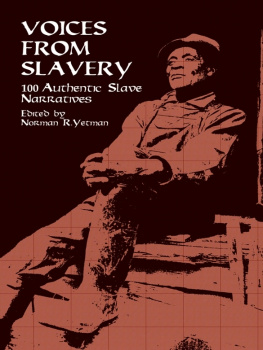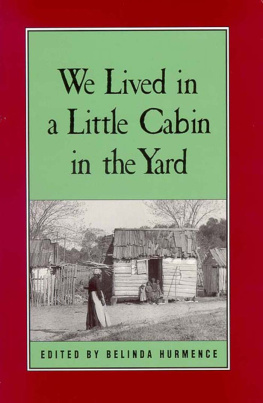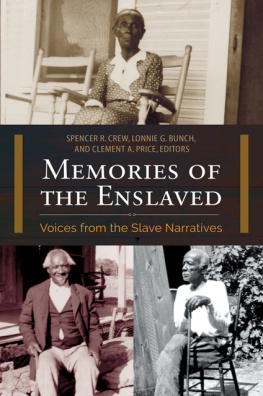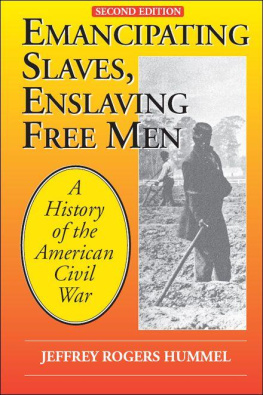How the Slaves Saw the Civil War
Recollections of the War through the WPA Slave Narratives
Herbert C. Covey
Dwight Eisnach

Copyright 2014 Herbert C. Covey and Dwight Eisnach
All rights reserved. No part of this publication may be reproduced, stored in a retrieval system, or transmitted, in any form or by any means, electronic, mechanical, photocopying, recording, or otherwise, except for the inclusion of brief quotations in a review, without prior permission in writing from the publisher.
Library of Congress Cataloging-in-Publication Data
Covey, Herbert C.
How the slaves saw the Civil War : recollections of the war through the WPA slave narratives / Herbert C. Covey and Dwight Eisnach.
pages cm
Includes bibliographical references and index.
ISBN 978-1-4408-2823-2 (pbk. : alk. paper) ISBN 978-1-4408-2824-9 (ebook)
1. United StatesHistoryCivil War, 18611865African Americans. 2. SlavesSouthern StatesHistory19th century. 3. Slave narrativesUnited States. 4. United StatesHistoryCivil War, 18611865Social aspects. I. Eisnach, Dwight. II. Title.
E453.C83 2014
973.7114dc23 2013035030
ISBN: 978-1-4408-2823-2
EISBN: 978-1-4408-2824-9
18 17 16 15 14 1 2 3 4 5
This book is also available on the World Wide Web as an e-book.
Visit www.abc-clio.com for details.
Praeger
An Imprint of ABC-CLIO, LLC
ABC-CLIO, LLC
130 Cremona Drive, P.O. Box 1911
Santa Barbara, California 93116-1911
This book is printed on acid-free paper 
Manufactured in the United States of America
How the Slaves Saw the Civil War
Herbert C. Covey and Dwight Eisnach
PRAEGER
AN IMPRINT OF ABC-CLIO, LLC
Santa Barbara, California Denver, Colorado Oxford, England
This book is dedicated to the two most important supporters of our work, our spouses, Marty Covey and Linda Eisnach. Without their support and encouragement, we would not be able to embark on projects such as this.
Contents
Preface
PURPOSE OF THE BOOK
Slightly more than 150 years ago, more than 3 million men fought in the American Civil War, and 620,000, or about 2 percent of the U.S. population, died during the conflict. An estimated 6 million fatalities resulted from the war (Faust 2008, xi). Although it has been a century and a half since this seismic shift in our nations history, the war continues to draw our attention to its outcome. We continue to explore this almost incomprehensible American catharsis from every conceivable angle, trying to make sense of how neighbors, families, and fellow citizens could harm each other with such vigor and to what purpose.
The war dramatically affected every household on both sides and created a landscape where friends became foes and brothers became adversaries. It was a time of great controversy among Americans, as differences of opinion abounded on what the war meant and on its implications for the future of the United States. Divisions across American society had never been wider. Even President Abraham Lincolns family was split on the issue, as he had in-laws who fought for the South. Even today, the war remains controversial and a subject of debate.
For many years, African Americans contributions to and participation in the Civil War have been minimized (Shackel 2001). Historians and other shapers of the public memory have characterized the war as essentially a collection of great white heroes, North and South, fighting a series of battles but for shifting purposes as the war evolved. This effort created a legacy of the war as being something other than what it was mostly for: a war that was fought in uncommon times by mostly common peopleAfrican American, white, and indigenous. Numerous volumes of detailed research have covered the Civil War, and considerable information has been garnered regarding major personalities as well as battles and war strategies and their outcomes. However, as Marvin Cain (1982) has suggested, the human equationthat is, the daily lives and attitudes of the soldiers who fought the Civil Warhas been neglected. We would add that the same neglect applies for the many slaves who also lived through, fought in, and survived the war.
What has received less attention has been the stories of many ex-slaves about how they perceived and experienced the war as well as what the war meant to them. It is important to acknowledge from the very beginning that it is wrong to assume that the war was experienced in any uniform manner by slaves, freedmen, or whites on either side. Rather, it was experienced in a multitude of ways. It would be serious injustice to the wars story to collapse the African American experience into simple categories and generalities. There were some commonalities, such as the great battles and personalities, but slaves and freedmen alike had their own personal experiences, interpretations, and observations. This book attempts to capture some of these individual experiences of ex-slaves in their own words or at least as close as we can interpret what they had to say.
We focus on the recollections of ex-slaves and their living experiences during that tumultuous time (Covey 2007; Covey and Eisnach 2009) and draw upon previous research on the Civil War, but we mostly rely on the Works Progress Administration (WPA) ex-slave narratives. The book also relies on selected earlier narratives (autobiographies), primary documents, and secondary sources when referencing the Civil War. The WPA narratives provide first-person accounts of the antebellum and war period. We believe that often the narratives speak for themselves and provide a rich and often moving record of how the ex-slaves experienced the extraordinary events of the war. The WPA respondents were witnesses to not only the major historical war-related events but also to the smaller daily affairs that were woven into the fabric of the war. Our objective was to determine how slaves experienced the war in their own words. Much of the information presented stems from direct quotations from the WPA narratives coupled with our own observations and those of others.
THE SOCIAL CONTEXT OF THE NARRATIVES
Most of the narratives were collected in the 1930s and 1940s during the Great Depression. The Depression was a difficult time for most people and was particularly hard for older African Americans (Wolters 1975). Even in the best of times, many African Americans lived in abject poverty (Dollard 1957; Myrdal 1962), but during the Depression, African American incomes were exceptionally low. Census data from 1920 and 1930 on employment also indicate that African Americans were disproportionately employed in traditionally low-income jobs. In 1920 and 1930, 67.3 percent and 64.7 percent, respectively, of African Americans who were gainfully employed worked in low-income agricultural or domestic service occupational groups (U.S. Bureau of the Census 1923, 1933, 1975). After slavery, the legacy of sharecropping and tenant farming systems persisted well into the Depression, transforming many rural African Americans into debtors.
Because WPA interviewers conducted the interviews where the ex-slaves lived, the interviewers had direct exposure to the impoverished lives of the respondents. The WPA narratives, in comments by both the interviewers and interviewees, provide a sense of the extreme poverty faced by African Americans during the Depression in the rural South (Bailey 1980; Thomas 1995; Yetman 1984). Of the living conditions of the interviewees, the historian C. Vann Woodward (1974, 474) remarked that After all, these were old and helpless people, often living alone in the worst years of the Great Depression, sometimes admitting they were hungry and not knowing where the next meal was coming from. Others survived the Depression satisfactorily as long as they performed needed tasks on their small farms and plots of land (Gordon 1979). The desire for the steady meals present under slavery, regardless of their adequacy, was expressed by some respondents (Escott 1979), and some even indicated that they were well fed under slavery (Joyner 1971). This claim is more evident in the WPA narratives than in earlier autobiographical narratives written before the Civil War (Bailey 1980). Respondents living conditions at the time of the interviews affected how some recalled slavery, with some respondents saying that life was better under slavery.











